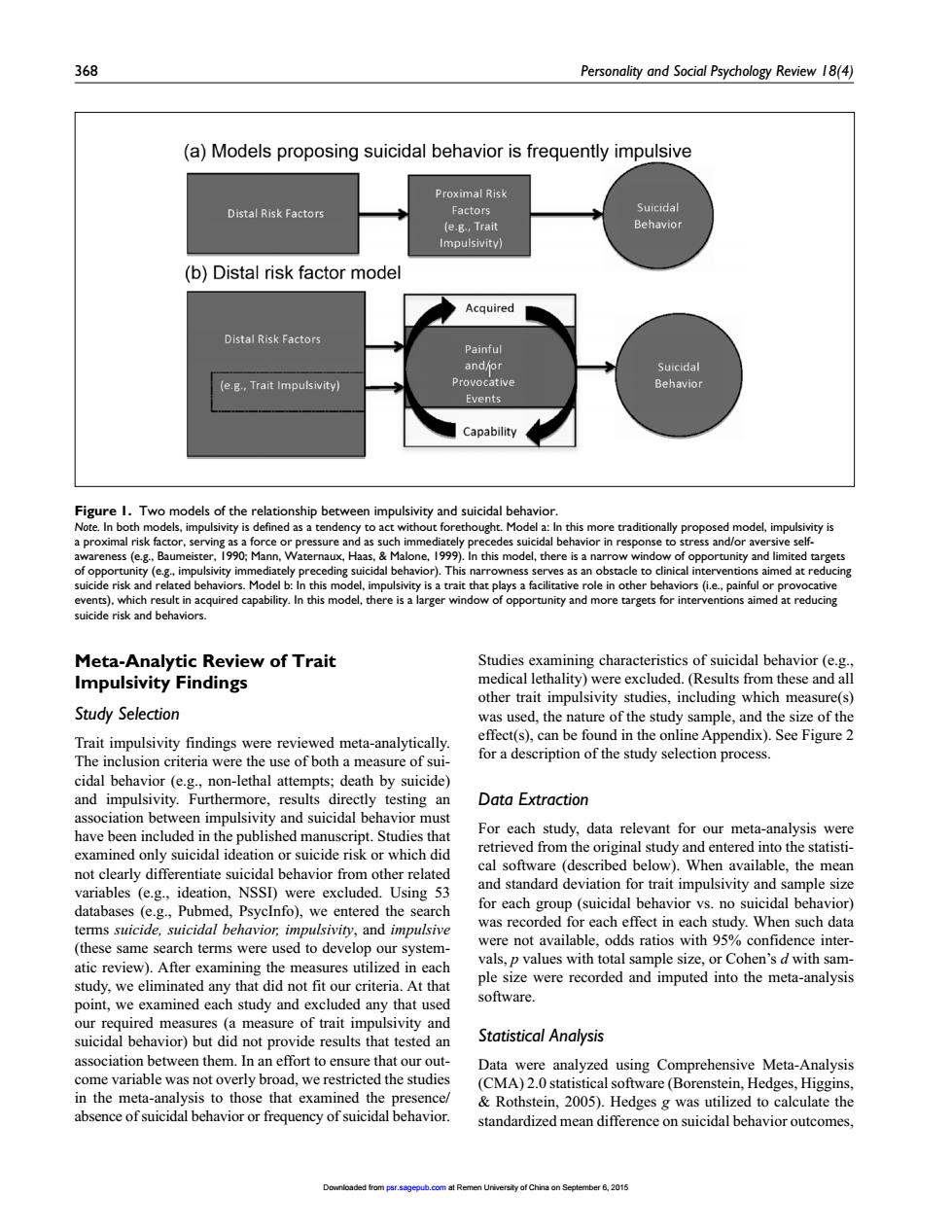正在加载图片...

368 Personality and Social Psychology Review18( (a)Models proposing suicidal behavior is frequently impulsive Proximal Risk Distal Risk Factor (b)Distal risk factor model Acquired Distal Risk Factor (e.g-,Trait Impulsivity Events Capability of the del imp proximal ure and as such imn or in e.g. etodni9portun Model ole in o which ide risk and behaviors Meta-Analytic Review of Trait Impulsivity Findings cacics of u b Study Selection Trait impulsivity findings were reviewed meta-analytically. cffect(s).can be found in the online Appendix).Sce Figure 2 for a description of the study selection process. Data Extraction association between impulsivity and suicidal behavior must For each study,data relevant for our meta-analysis were ve been included in the pation or suicide risk or whien did y variables (e.g ideation.NSSD)were excluded.Using ation fo 53 databases(e.g,Pubmed,Psyclnfo),we entered the sea for each gr p(suicidal behavior vs.no suicidal behavior was recorded for each effect in each study.When such data odds ratios with 95 ese same fte confidence inter erms were u study,we eliminated any that did not fit our criteria.At that eta. oftware point,we examined each study and excluded any that use t trait Statistical Analysis association be them In e that ou come variable was not overly broad,we restricted the studies Meta-Analysis presence Rothstein,2005).Hedges g was utilized to calculate the standardized mean difference on suicidal behavior outcomes, te 6 2015 368 Personality and Social Psychology Review 18(4) Meta-Analytic Review of Trait Impulsivity Findings Study Selection Trait impulsivity findings were reviewed meta-analytically. The inclusion criteria were the use of both a measure of suicidal behavior (e.g., non-lethal attempts; death by suicide) and impulsivity. Furthermore, results directly testing an association between impulsivity and suicidal behavior must have been included in the published manuscript. Studies that examined only suicidal ideation or suicide risk or which did not clearly differentiate suicidal behavior from other related variables (e.g., ideation, NSSI) were excluded. Using 53 databases (e.g., Pubmed, PsycInfo), we entered the search terms suicide, suicidal behavior, impulsivity, and impulsive (these same search terms were used to develop our systematic review). After examining the measures utilized in each study, we eliminated any that did not fit our criteria. At that point, we examined each study and excluded any that used our required measures (a measure of trait impulsivity and suicidal behavior) but did not provide results that tested an association between them. In an effort to ensure that our outcome variable was not overly broad, we restricted the studies in the meta-analysis to those that examined the presence/ absence of suicidal behavior or frequency of suicidal behavior. Studies examining characteristics of suicidal behavior (e.g., medical lethality) were excluded. (Results from these and all other trait impulsivity studies, including which measure(s) was used, the nature of the study sample, and the size of the effect(s), can be found in the online Appendix). See Figure 2 for a description of the study selection process. Data Extraction For each study, data relevant for our meta-analysis were retrieved from the original study and entered into the statistical software (described below). When available, the mean and standard deviation for trait impulsivity and sample size for each group (suicidal behavior vs. no suicidal behavior) was recorded for each effect in each study. When such data were not available, odds ratios with 95% confidence intervals, p values with total sample size, or Cohen’s d with sample size were recorded and imputed into the meta-analysis software. Statistical Analysis Data were analyzed using Comprehensive Meta-Analysis (CMA) 2.0 statistical software (Borenstein, Hedges, Higgins, & Rothstein, 2005). Hedges g was utilized to calculate the standardized mean difference on suicidal behavior outcomes, Figure 1. Two models of the relationship between impulsivity and suicidal behavior. Note. In both models, impulsivity is defined as a tendency to act without forethought. Model a: In this more traditionally proposed model, impulsivity is a proximal risk factor, serving as a force or pressure and as such immediately precedes suicidal behavior in response to stress and/or aversive selfawareness (e.g., Baumeister, 1990; Mann, Waternaux, Haas, & Malone, 1999). In this model, there is a narrow window of opportunity and limited targets of opportunity (e.g., impulsivity immediately preceding suicidal behavior). This narrowness serves as an obstacle to clinical interventions aimed at reducing suicide risk and related behaviors. Model b: In this model, impulsivity is a trait that plays a facilitative role in other behaviors (i.e., painful or provocative events), which result in acquired capability. In this model, there is a larger window of opportunity and more targets for interventions aimed at reducing suicide risk and behaviors. Downloaded from psr.sagepub.com at Remen University of China on September 6, 2015